Non-Trivial Dynamics in the FizHugh–Rinzel Model and Non-Homogeneous Oscillatory-Excitable Reaction-Diffusions Systems
Abstract
Simple Summary
Abstract
1. Introduction
2. Methods
2.1. The FHR System
2.2. A Non-Homogeneous FHN Model (Nh-FHN)
3. Analysis of the FHR System
3.1. A Short Background on FHN
3.1.1. A System with MMOs
3.1.2. MMOs and Focus
3.1.3. MMOs and Canards
3.2. Basic Stability Analysis
3.3. Absorbing Set, Existence of Periodic Solution, Numerical Approximation
3.4. A Numerical Approximation for Small Oscillations
3.5. Slow-Fast Analysis
4. Dynamics in the Nh-FHN Model
4.1. Existence and Uniqueness of the Stationary Solution
4.2. Numerical Experiments
4.2.1. Filtering of Frequencies and Local Mixed Mode Oscillations (MMOs)
4.2.2. Fade of Wave Propagation (Death Spot)
5. Discussion
6. Conclusions
Author Contributions
Funding
Institutional Review Board Statement
Informed Consent Statement
Data Availability Statement
Conflicts of Interest
References
- FitzHugh, R. Impulses and Physiological States in Theoretical Models of Nerve Membrane. Biophys. J. 1961, 1, 445–466. [Google Scholar] [CrossRef]
- Nagumo, J.; Arimoto, S.; Yoshizawa, S. An Active Pulse Transmission Line Simulating Nerve Axon. Proc. IRE 1962, 50, 2061–2070. [Google Scholar] [CrossRef]
- Hodgkin, A.L.; Huxley, A.F. A quantitative description of membrane current and its application to conduction and excitation in nerve. J. Physiol. 1952, 117, 500–544. [Google Scholar] [CrossRef] [PubMed]
- Lyu, C.; Abbott, L.F.; Maimon, G. Building an allocentric travelling direction signal via vector computation. Nature 2021, 601, 92–97. [Google Scholar] [CrossRef]
- Chariker, L.; Shapley, R.; Young, L.S. Orientation Selectivity from Very Sparse LGN Inputs in a Comprehensive Model of Macaque V1 Cortex. J. Neurosci. 2016, 36, 12368–12384. [Google Scholar] [CrossRef] [PubMed]
- Chariker, L.; Shapley, R.; Young, L.S. Rhythm and Synchrony in a Cortical Network Model. J. Neurosci. 2018, 38, 8621–8634. [Google Scholar] [CrossRef] [PubMed]
- Volpert, V.; Xu, B.; Tchechmedjiev, A.; Harispe, S.; Aksenov, A.; Mesnildrey, Q.; Beuter, A. Characterization of spatiotemporal dynamics in EEG data during picture naming with optical flow patterns. Math. Biosci. Eng. 2023, 20, 11429–11463. [Google Scholar] [CrossRef]
- Panfilov, L.L.A.; Dierckx, H. Impact of Electrode Orientation, Myocardial Wall Thickness and Myofiber Direction on Intracardiac Electrograms: Numerical Modeling and Analytical Solutions. Front. Physiol. Sec. Card. Electrophysiol. 2023, 14. [Google Scholar]
- Harlaar, N.; Dekker, S.O.; Zhang, J.; Snabel, R.R.; Veldkamp, M.W.; Verkerk, A.O.; Fabres, C.C.; Schwach, V.; Lerink, L.J.S.; Rivaud, M.R.; et al. Conditional immortalization of human atrial myocytes for the generation of in vitro models of atrial fibrillation. Nat. Biomed. Eng. 2022, 6, 389–402. [Google Scholar] [CrossRef]
- Maia, P.D.; Kutz, J.N. Identifying critical regions for spike propagation in axon segments. J. Comput. Neurosci. 2013, 36, 141–155. [Google Scholar] [CrossRef]
- Ambrosio, B.; Francoise, J.P. Propagation of bursting oscillations. Philos. Trans. R. Soc. A Math. Phys. Eng. Sci. 2009, 367, 4863–4875. [Google Scholar] [CrossRef]
- Ambrosio, B. Hopf Bifurcation in an Oscillatory-Excitable Reaction–Diffusion Model with Spatial Heterogeneity. Int. J. Bifurc. Chaos 2017, 27, 1750065. [Google Scholar] [CrossRef]
- Ambrosio, B. Qualitative analysis of certain reaction-diffusion systems of the FitzHugh-Nagumo type. Evol. Equ. Control Theory 2023. [Google Scholar] [CrossRef]
- Kopell, N.; Howard, L.N. Plane Wave Solutions to Reaction-Diffusion Equations. Stud. Appl. Math. 1973, 52, 291–328. [Google Scholar] [CrossRef]
- Rinzel, J.; Keller, J.B. Traveling Wave Solutions of a Nerve Conduction Equation. Biophys. J. 1973, 13, 1313–1337. [Google Scholar] [CrossRef]
- Rinzel, J. Spatial stability of traveling wave solutions of a nerve conduction equation. Biophys. J. 1975, 15, 975–988. [Google Scholar] [CrossRef] [PubMed]
- Rinzel, J.; Terman, D. Propagation Phenomena in a Bistable Reaction-Diffusion System. SIAM J. Appl. Math. 1982, 42, 1111–1137. [Google Scholar] [CrossRef]
- Jones, C.K.R.T. Stability of the travelling wave solution of the FitzHugh-Nagumo system. Trans. Amer. Math. Soc. 1984, 286, 431–469. [Google Scholar] [CrossRef]
- Ermentrout, G.B.; Rinzel, J. Reflected Waves in an Inhomogeneous Excitable Medium. SIAM J. Appl. Math. 1996, 56, 1107–1128. [Google Scholar] [CrossRef]
- Carter, P.; Sandstede, B. Fast Pulses with Oscillatory Tails in the FitzHugh–Nagumo System. SIAM J. Math. Anal. 2015, 47, 3393–3441. [Google Scholar] [CrossRef]
- Cornwell, P.; Jones, C.K.R.T. On the Existence and Stability of Fast Traveling Waves in a Doubly Diffusive FitzHugh–Nagumo System. SIAM J. Appl. Dyn. Syst. 2018, 17, 754–787. [Google Scholar] [CrossRef]
- Volpert, A.; Volpert, V.; Volpert, V. Traveling Wave Solutions of Parabolic Systems; American Mathematical Society: Providence, RI, USA, 1994. [Google Scholar] [CrossRef]
- Sandstede, B. Chapter 18—Stability of Travelling Waves. In Handbook of Dynamical Systems; Fiedler, B., Ed.; Elsevier Science: Amsterdam, The Netherlands, 2002; Volume 2, pp. 983–1055. [Google Scholar] [CrossRef]
- Volpert, V.; Petrovskii, S. Reaction–diffusion waves in biology. Phys. Life Rev. 2009, 6, 267–310. [Google Scholar] [CrossRef]
- Rinzel, J. A Formal Classification of Bursting Mechanisms in Excitable Systems. In Proceedings of the International Congress of Mathematicians, Berkeley, CA, USA, 3–11 August 1986. [Google Scholar]
- Rinzel, J. A Formal Classification of Bursting Mechanisms in Excitable Systems. In Mathematical Topics in Population Biology, Morphogenesis and Neurosciences: Proceedings of an International Symposium Held in Kyoto, Japan, 10–15 November 1985; Teramoto, E., Yumaguti, M., Eds.; Springer: Berlin/Heidelberg, Germany, 1987; pp. 267–281. [Google Scholar]
- Desroches, M.; Rinzel, J.; Rodrigues, S. Classification of bursting patterns: A tale of two ducks. PLoS Comput. Biol. 2022, 18, e1009752. [Google Scholar] [CrossRef] [PubMed]
- Izhikevich, E.M. Synchronization of elliptic bursters. SIAM Rev. 2001, 43, 315–344. [Google Scholar] [CrossRef]
- Mondal, A.; Sharma, S.K.; Upadhyay, R.K.; Mondal, A. Firing activities of a fractional-order FitzHugh-Rinzel bursting neuron model and its coupled dynamics. Sci. Rep. 2019, 9, 15721. [Google Scholar] [CrossRef]
- Wojcik, J.; Shilnikov, A. Voltage Interval Mappings for an Elliptic Bursting Model. In Nonlinear Systems and Complexity; Springer International Publishing: New York, NY, USA, 2015; pp. 195–213. [Google Scholar]
- Clément, F.; Françoise, J.P. Mathematical Modeling of the GnRH Pulse and Surge Generator. SIAM J. Appl. Dyn. Syst. 2007, 6, 441–456. [Google Scholar] [CrossRef]
- Vidal, A.; Clément, F. A Dynamical Model for the Control of the Gonadotrophin-Releasing Hormone Neurosecretory System. J. Neuroendocrinol. 2010, 22, 1251–1266. [Google Scholar] [CrossRef]
- Albizuri, J.U.; Desroches, M.; Krupa, M.; Rodrigues, S. Inflection, Canards and Folded Singularities in Excitable Systems: Application to a 3D FitzHugh–Nagumo Model. J. Nonlinear Sci. 2020, 30, 3265–3291. [Google Scholar] [CrossRef]
- Desroches, M.; Krupa, M.; Rodrigues, S. Inflection, canards and excitability threshold in neuronal models. J. Math. Biol. 2012, 67, 989–1017. [Google Scholar] [CrossRef]
- Amir, R.; Michaelis, M.; Devor, M. Burst Discharge in Primary Sensory Neurons: Triggered by Subthreshold Oscillations, Maintained by Depolarizing Afterpotentials. J. Neurosci. 2002, 22, 1187–1198. [Google Scholar] [CrossRef]
- Bertram, R. Mathematical Modeling in Neuroendocrinology. Compr. Physiol. 2015. [CrossRef]
- Fletcher, P.A.; Thompson, B.; Liu, C.; Bertram, R.; Satin, L.S.; Sherman, A.S. Ca2+ release or Ca2+ entry, that is the question: What governs Ca2+ oscillations in pancreatic β cells? Am. J. Physiol.-Endocrinol. Metab. 2023, 324, E477–E487. [Google Scholar] [CrossRef]
- Desroches, M.; Guckenheimer, J.; Krauskopf, B.; Kuehn, C.; Osinga, H.M.; Wechselberger, M. Mixed-Mode Oscillations with Multiple Time Scales. SIAM Rev. 2012, 54, 211–288. [Google Scholar] [CrossRef]
- Letson, B.; Rubin, J.E.; Vo, T. Analysis of Interacting Local Oscillation Mechanisms in Three-Timescale Systems. SIAM J. Appl. Math. 2017, 77, 1020–1046. [Google Scholar] [CrossRef]
- Kaklamanos, P.; Popović, N.; Kristiansen, K.U. Bifurcations of mixed-mode oscillations in three-timescale systems: An extended prototypical example. Chaos Interdiscip. J. Nonlinear Sci. 2022, 32, 013108. [Google Scholar] [CrossRef] [PubMed]
- Kuehn, C. Multiple Time Scale Dynamics; Springer International Publishing: Berlin/Heidelberg, Germany, 2015. [Google Scholar] [CrossRef]
- Ambrosio, B.; Mintchev, S.M. Periodically kicked feedforward chains of simple excitable FitzHugh–Nagumo neurons. Nonlinear Dyn. 2022, 110, 2805–2829. [Google Scholar] [CrossRef]
- Glendinning, P.; Sparrow, C. Local and global behavior near homoclinic orbits. J. Stat. Phys. 1984, 35, 645–696. [Google Scholar] [CrossRef]
- Shilnikov, L.; Shilnikov, A. Shilnikov bifurcation. Scholarpedia 2007, 2, 1891. [Google Scholar] [CrossRef]
- Szmolyan, P.; Wechselberger, M. Canards in R3. J. Differ. Equ. 2001, 177, 419–453. [Google Scholar] [CrossRef]
- Abbott, L. Lapicque’s introduction of the integrate-and-fire model neuron (1907). Brain Res. Bull. 1999, 50, 303–304. [Google Scholar] [CrossRef]
- Krupa, M.; Szmolyan, P. Extending Geometric Singular Perturbation Theory to Nonhyperbolic Points—Fold and Canard Points in Two Dimensions. SIAM J. Math. Anal. 2001, 33, 286–314. [Google Scholar] [CrossRef]
- Krupa, M.; Ambrosio, B.; Aziz-Alaoui, M.A. Weakly coupled two-slow–two-fast systems, folded singularities and mixed mode oscillations. Nonlinearity 2014, 27, 1555–1574. [Google Scholar] [CrossRef]
- Krupa, M.; Popović, N.; Kopell, N. Mixed-mode oscillations in three time-scale systems: A prototypical example. SIAM J. Appl. Dyn. Syst. 2008, 7, 361–420. [Google Scholar] [CrossRef]
- De Maesschalck, P.; Kutafina, E.; Popović, N. Three time-scales in an extended Bonhoeffer–van der Pol oscillator. J. Dyn. Differ. Equ. 2014, 26, 955–987. [Google Scholar] [CrossRef]
- Boccardo, L.; Croce, G. Elliptic Partial Differential Equations; De Gruyter: Gottingen, Germany, 2013. [Google Scholar]
- Yanagita, T.; Nishiura, Y.; Kobayashi, R. Signal propagation and failure in one-dimensional FitzHugh-Nagumo equations with periodic stimuli. Phys. Rev. E 2005, 71, 036226. [Google Scholar] [CrossRef]


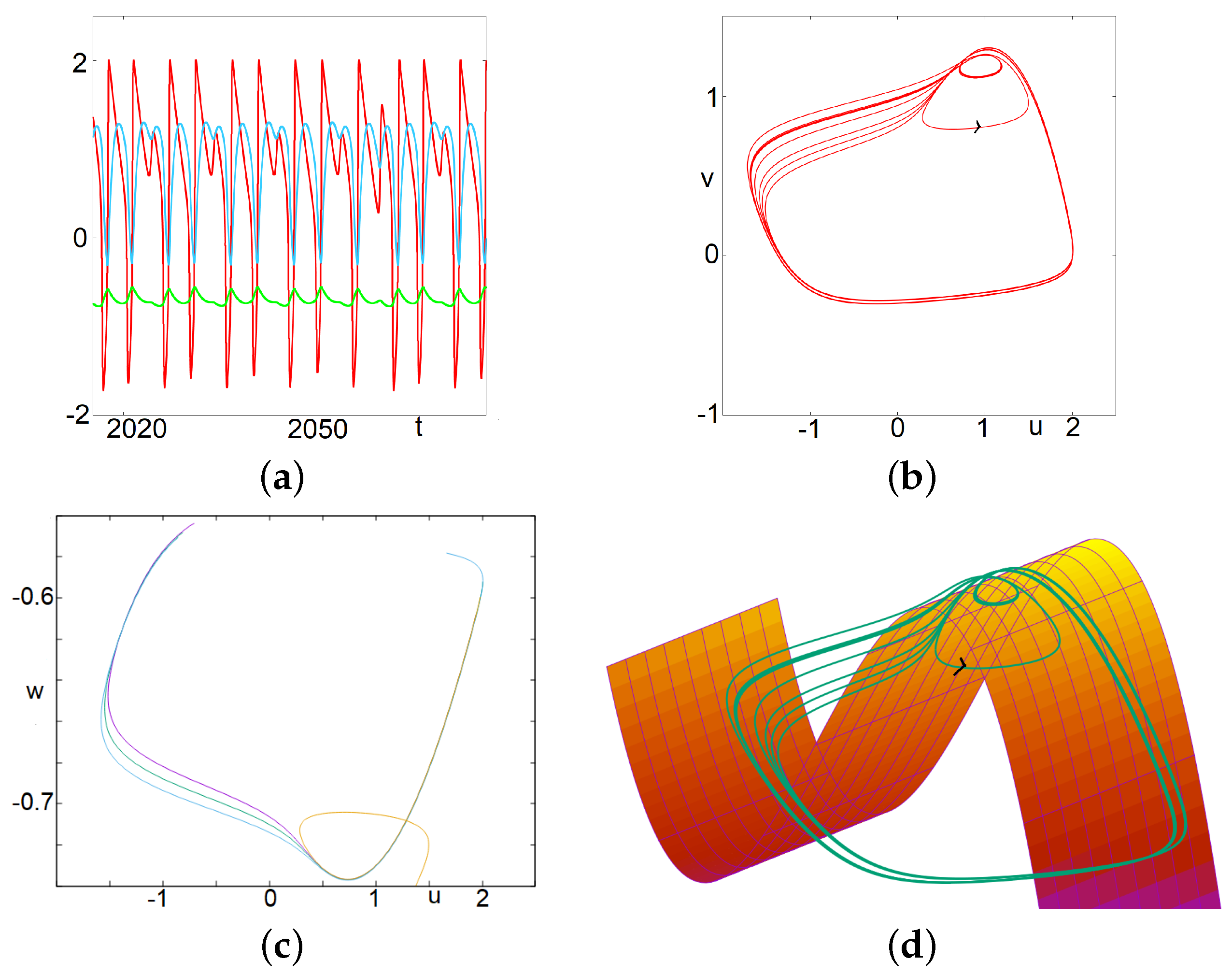
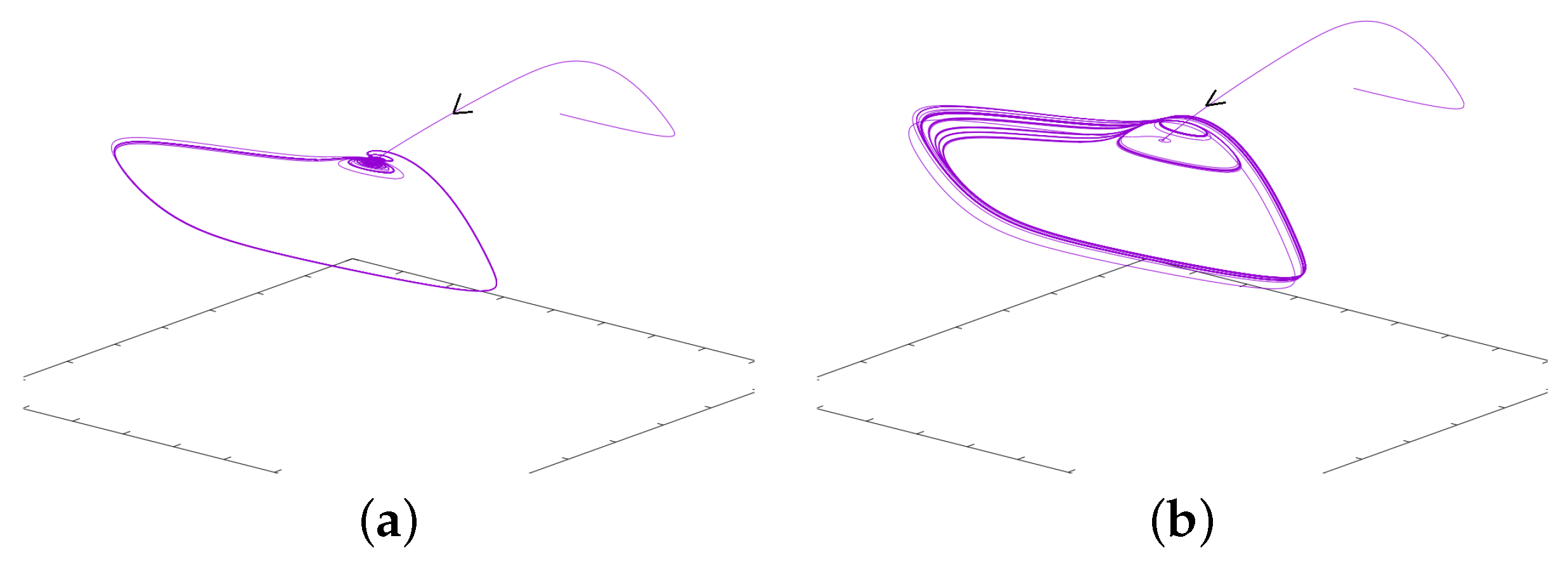
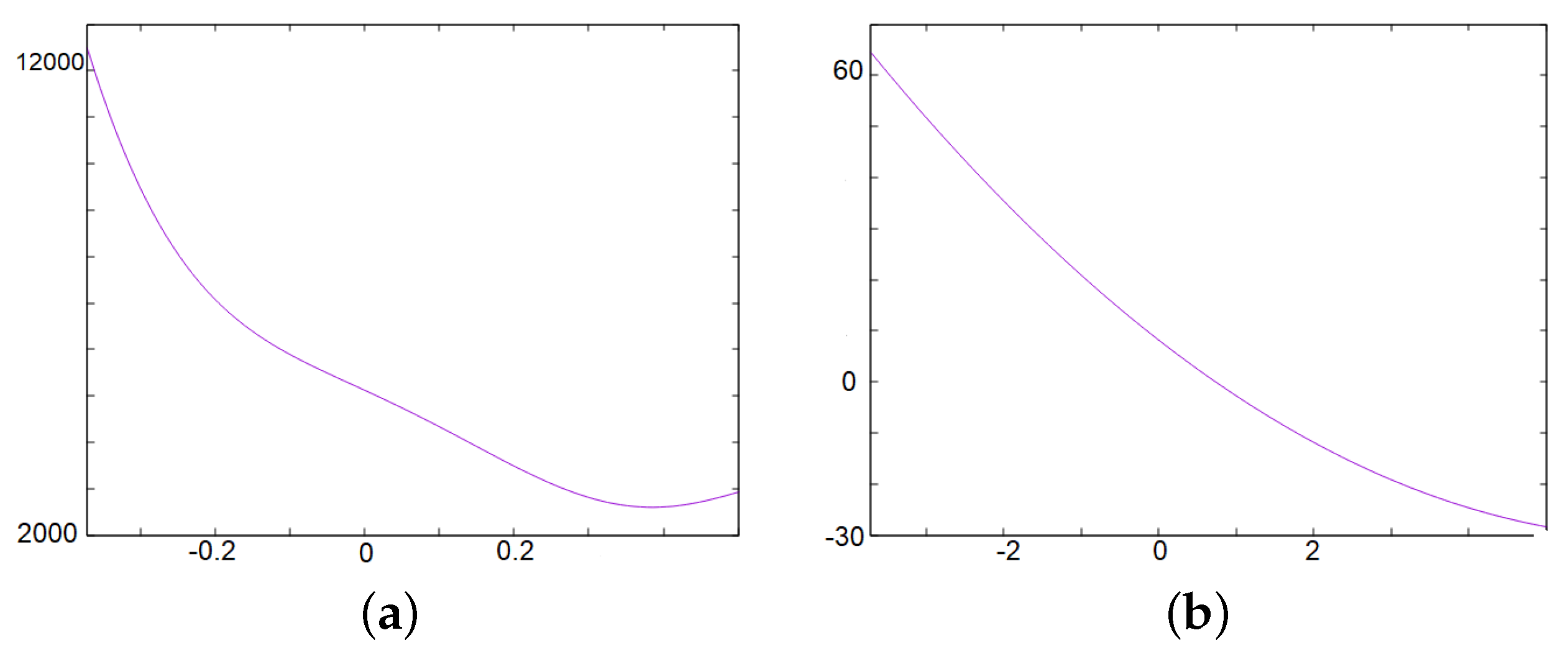

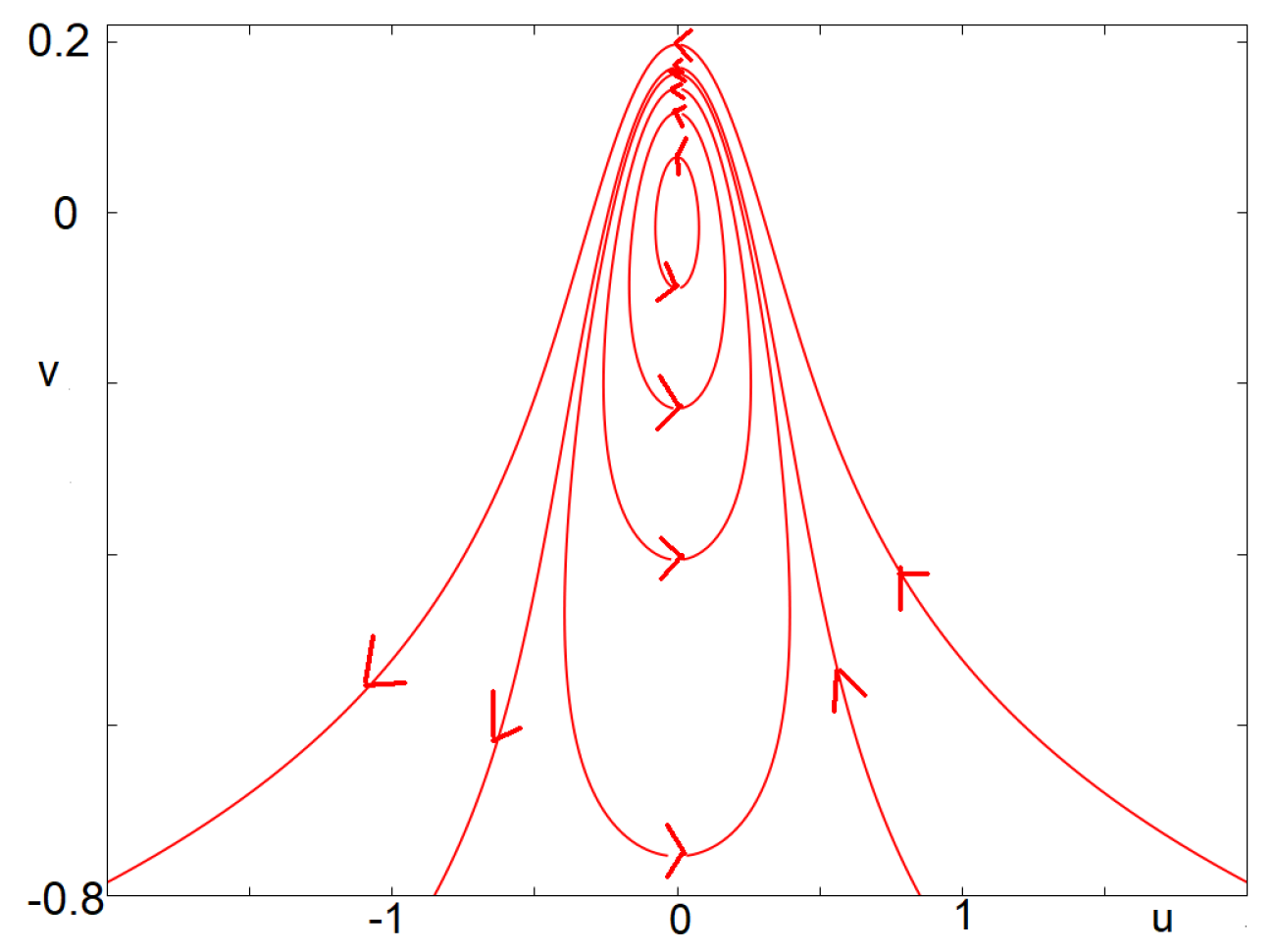
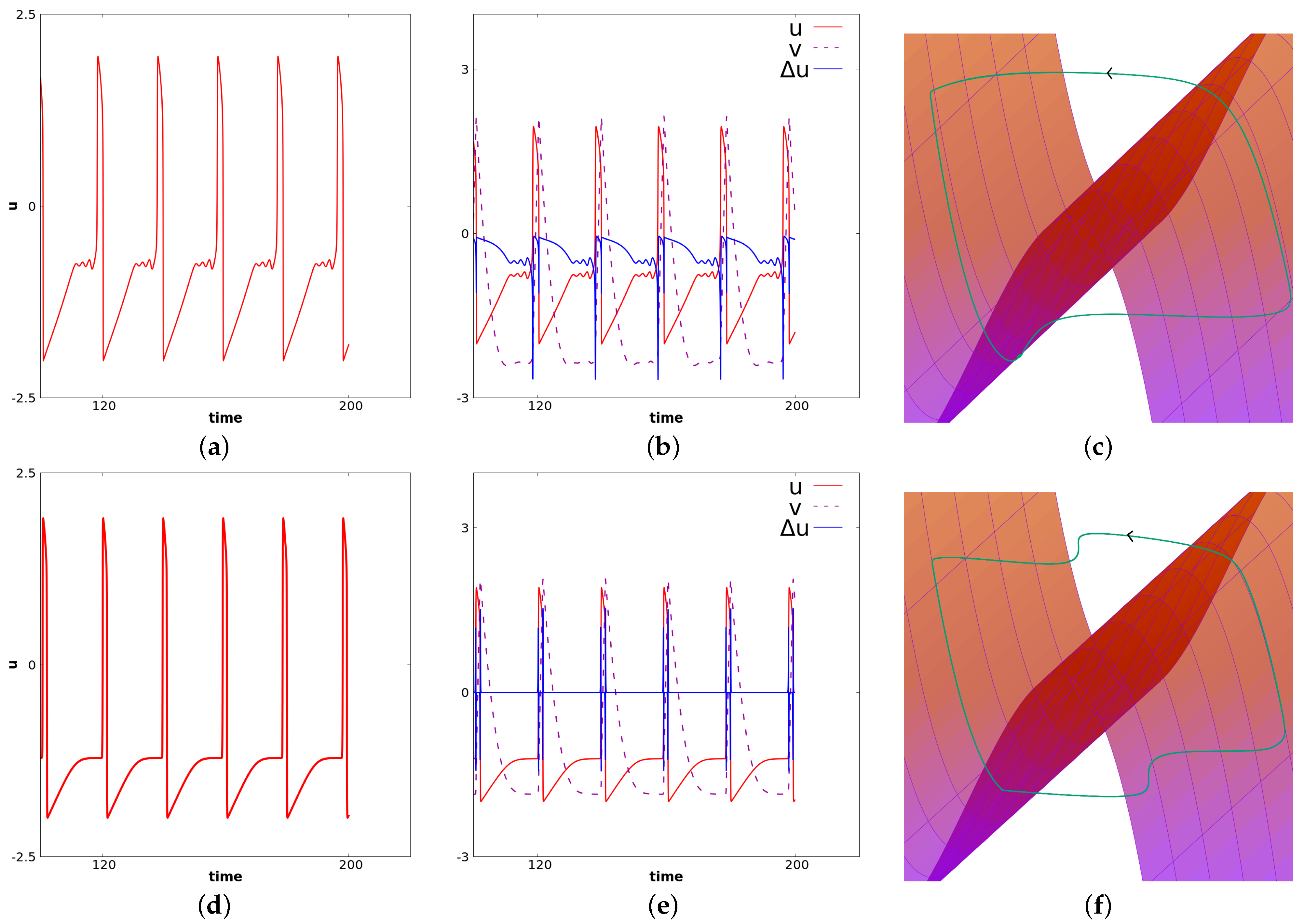

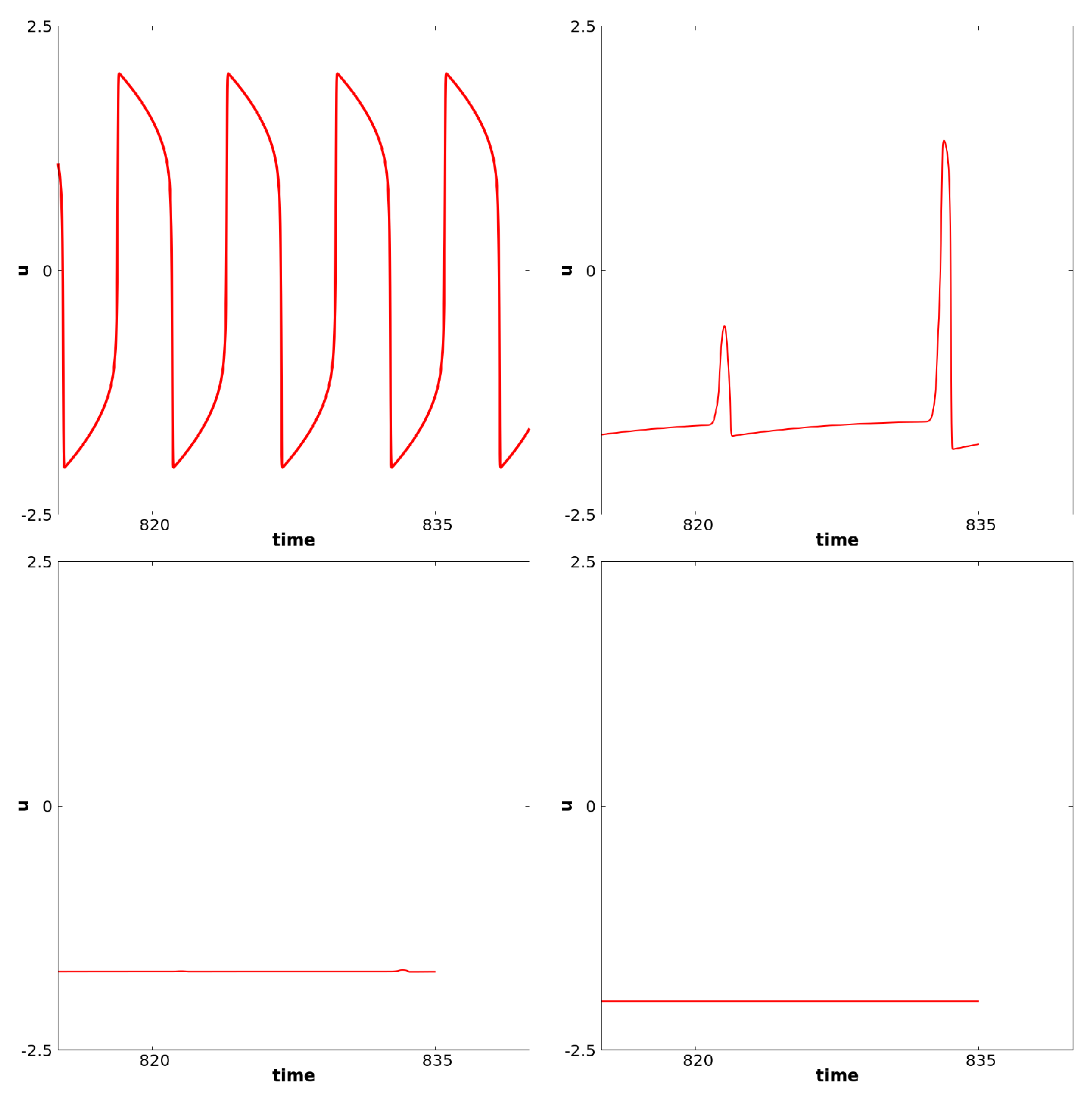
Disclaimer/Publisher’s Note: The statements, opinions and data contained in all publications are solely those of the individual author(s) and contributor(s) and not of MDPI and/or the editor(s). MDPI and/or the editor(s) disclaim responsibility for any injury to people or property resulting from any ideas, methods, instructions or products referred to in the content. |
© 2023 by the authors. Licensee MDPI, Basel, Switzerland. This article is an open access article distributed under the terms and conditions of the Creative Commons Attribution (CC BY) license (https://creativecommons.org/licenses/by/4.0/).
Share and Cite
Ambrosio, B.; Aziz-Alaoui, M.A.; Mondal, A.; Mondal, A.; Sharma, S.K.; Upadhyay, R.K. Non-Trivial Dynamics in the FizHugh–Rinzel Model and Non-Homogeneous Oscillatory-Excitable Reaction-Diffusions Systems. Biology 2023, 12, 918. https://doi.org/10.3390/biology12070918
Ambrosio B, Aziz-Alaoui MA, Mondal A, Mondal A, Sharma SK, Upadhyay RK. Non-Trivial Dynamics in the FizHugh–Rinzel Model and Non-Homogeneous Oscillatory-Excitable Reaction-Diffusions Systems. Biology. 2023; 12(7):918. https://doi.org/10.3390/biology12070918
Chicago/Turabian StyleAmbrosio, Benjamin, M. A. Aziz-Alaoui, Argha Mondal, Arnab Mondal, Sanjeev K. Sharma, and Ranjit Kumar Upadhyay. 2023. "Non-Trivial Dynamics in the FizHugh–Rinzel Model and Non-Homogeneous Oscillatory-Excitable Reaction-Diffusions Systems" Biology 12, no. 7: 918. https://doi.org/10.3390/biology12070918
APA StyleAmbrosio, B., Aziz-Alaoui, M. A., Mondal, A., Mondal, A., Sharma, S. K., & Upadhyay, R. K. (2023). Non-Trivial Dynamics in the FizHugh–Rinzel Model and Non-Homogeneous Oscillatory-Excitable Reaction-Diffusions Systems. Biology, 12(7), 918. https://doi.org/10.3390/biology12070918






